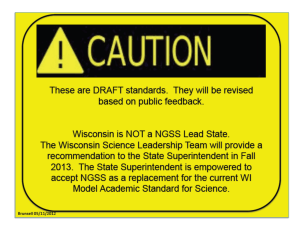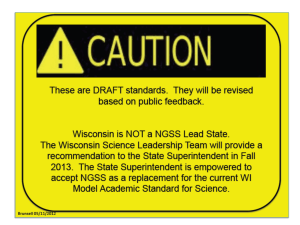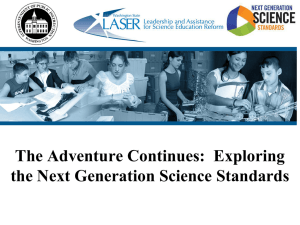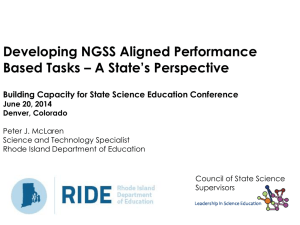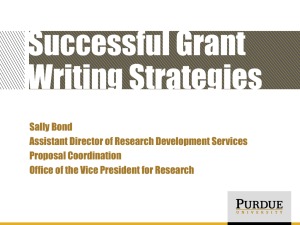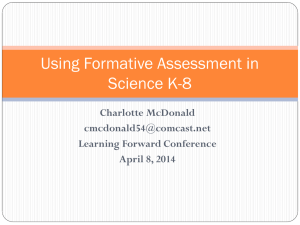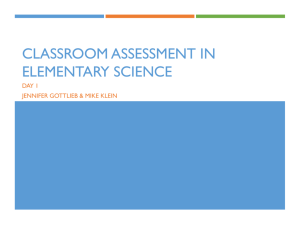CSTA Presentation Palm Springs PPT
advertisement
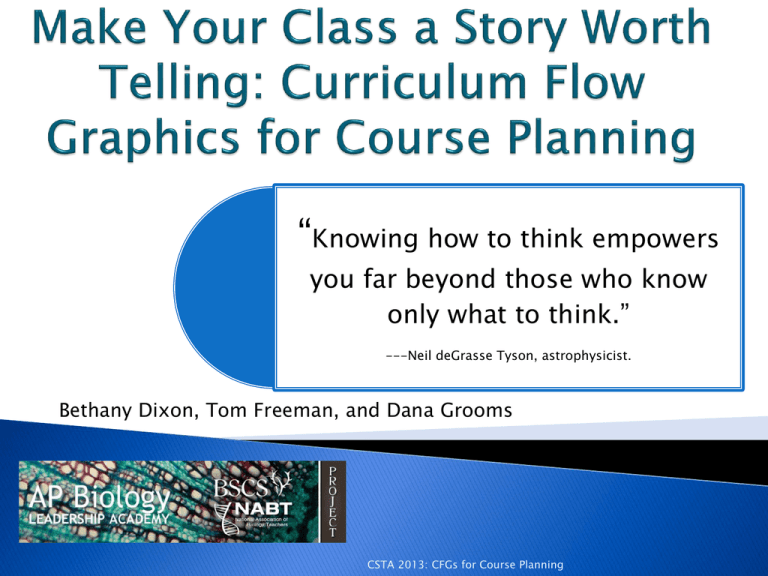
“Knowing how to think empowers you far beyond those who know only what to think.” ---Neil deGrasse Tyson, astrophysicist. Bethany Dixon, Tom Freeman, and Dana Grooms CSTA 2013: CFGs for Course Planning 1. 2. 3. Finding your course themes Structuring a meaningful storyline Scheduling activities for impact Multiple objectives: (Science content, process, communication skills) interconnected ideas that span the document Few Ready-made references exist Based on the K-12 Science Framework, these are the core concepts needed to be a scientifically literate individual in each of the major core disciplines What you should be teaching and the depth to which it should be taught at each grade level Includes assessment boundaries to clarify the depth of knowledge that is expected Performance Expectations: What the students should know and be able to do after instruction; includes: ◦ Clarification statements-gives examples ◦ Assessment boundaries-limits to assessment questions Disciplinary Core Ideas: Broken down into Life, Physical, Earth Science and Engineering/Technology Application; This is the content, in progression from K-12 Science and Engineering Practices: The knowledge and skills the students should possess; the application of science Crosscutting Concepts: Fundamental concepts that bridge all the Disciplinary Core Ideas Curriculum planning carefully is good practice It takes time Structure and strategies to improve it will help Overall course design (connections) are usually obvious to teachers but may not be to students CFGs can be shared with students as a curriculum guide HHMI BioInteractive Resources Includes all “NGSS” pieces Well thought-out Embedded ◦ Formative assessment ◦ Metacognition ◦ Science and Engineering Practices ◦ Review ◦ Summative Assessments Curriculum Flow Graphics Publically represent a coherent storyline as we sequence crosscutting concepts related to disciplinary core ideas (content goals) with the statements of performance expectations (themes). What do you notice about the representation? Built with a connection to an overall Core Idea: ◦ Theme will connect the course through different topics. Each unit is sequenced around the 5E model Each unit links together questions that tie in each lesson. What NGSS has given us is what the students need to know: not how to help them know it: 1. Read the colored cards for your NGSS Standard with your table. Arrange your disciplinary core idea cards in a logical storyline that helps address the concepts in the NGSS. Record on sticky notes activities that you use that would support the core ideas. • • How well will students be able to make sense of the storyline? Are there missing concepts that students need to make sense of the content? ◦ At this point we would use the storyline, add in crosscutting concepts and science and engineering practices that are supported by your curriculum. ◦ Do any of your activities already support one of these concepts or practices? After the CFG is constructed, we need to incorporate both summative and formative assessment opportunities and add them into the plan. Return to your stoplight sheet: ◦ Do you feel a little more comfortable about some of the standards in your disciplinary area regarding the NGSS? (skip the “mid” assessment and go to the “post” column) How do you determine students’ prior knowledge of a learning target? How do you assess students before the summative assessment? How do you determine that student thinking has advanced? Elbow partner share "It is not an instrument or an event, but a collection of practices with a common feature: they all lead to some action that improves learning.” 7 Strategies for Formative Assessment (Chappuis, 2009). What Gives Formative Assessment Its Power? The collection of hundreds of studies Black & Wiliam (1998a, 1998b) examined represent a diverse array of interventions, all which featured some form of formative use of assessment data or processes. Practices yielding the largest achievement gains displayed the following characteristics: • Use of classroom discussions, classroom tasks, and homework to determine the current state of student understanding, with action plans take to improve learning/correct misunderstandings. Good teaching includes teaching processes of thought as well as content. Colored Craft Sticks Traffic Light Assessment Gots and Needs Gallery Walk Meta Moments Curated vs. Uncurated Constructive Student Comments “I wonder” “I notice” Add questions What are the benefits of using a CFG to frame your curriculum? What are the drawbacks? How can using CFGs impact your curriculum? Online stopwatch Traffic Light Formative Assessment Meta Moments HHMI Resources BSCS Resources Formative Assessment Sticks Gots and Needs closure Obtain two sticky notes Using the first sticky note, please write down one thing you “got” from today’s PD. On the second sticky note, write down one thing that you “need” with regard to CFGs or any of the material presented here today. When you have finished, please stick them to their posters. Please fill out a PD form so that we can improve in our practice. Thank you for your time and effort!
